Manage Your Compute
Edit and delete deployments, nodepools, and clusters
You can efficiently manage your deployments, nodepools, and clusters within the Clarifai's platform to optimize performance and costs, as well as fine-tune your compute environment for tasks like model inference.
You can easily edit configurations, adjust resource allocations, or remove unused resources to free up compute infrastructure as your workload requirements evolve.
Via the UI
Deployments
You can manage various aspects of your deployments by visiting the nodepool viewer page. The Deployments table displays all your current deployments within that nodepool, along with their associated models and deployed model versions.
The table also supports sorting, allowing you to organize entries alphabetically (A–Z or Z–A) as needed.
To manage a specific deployment, locate it in the table and click the three-dot menu at the end of its row. This reveals a list of available actions, such as editing, viewing logs, opening the model in the Playground, or deleting the deployment.
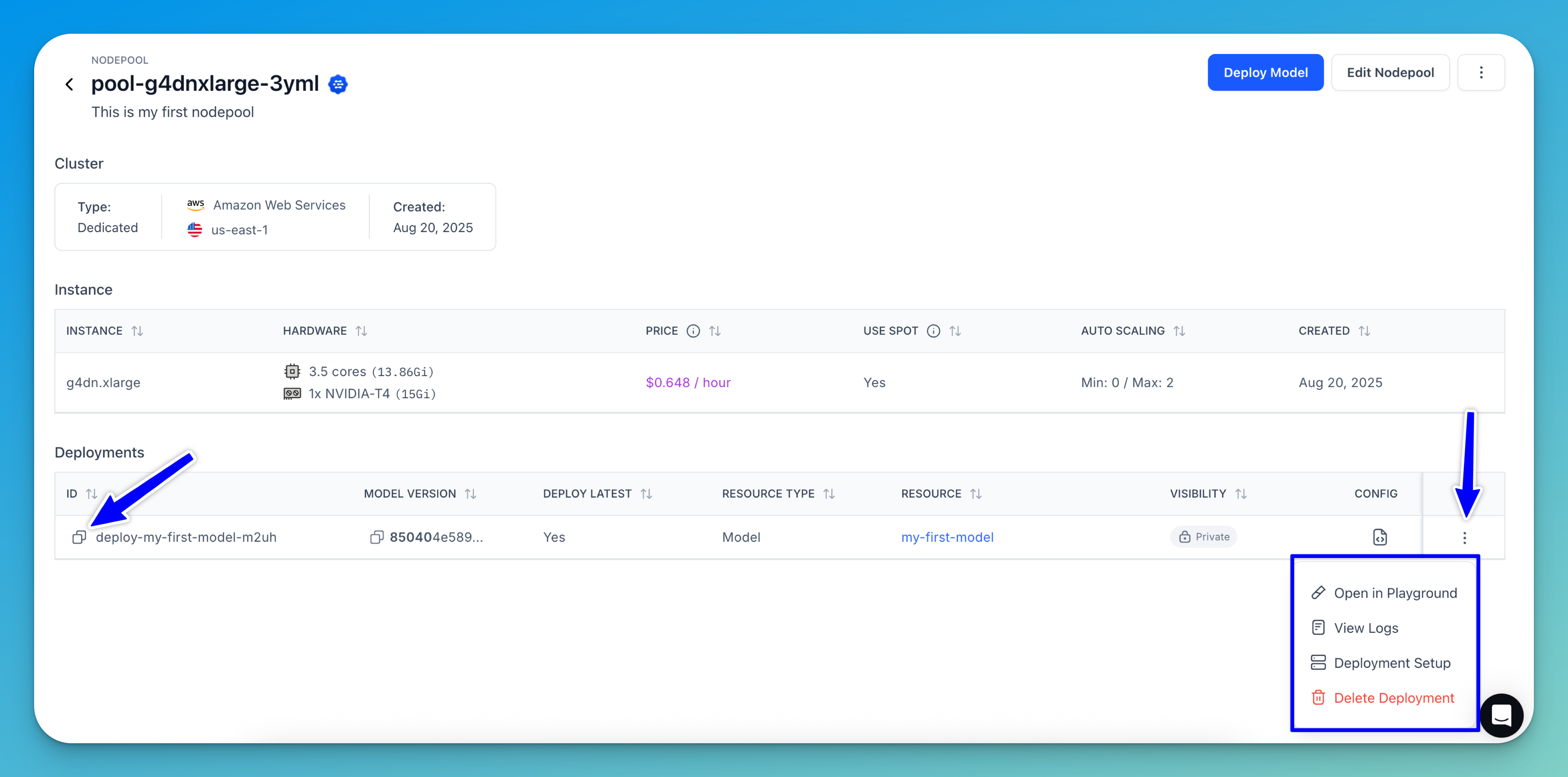
Copy Deployment ID
To copy a deployment ID, navigate to the Deployments table and locate the ID column. Find the ID you need, then click to copy it to your clipboard.
Open in Playground
To open a model in the Playground and test its performance, go to the Deployments table and click the three-dot menu at the end of the corresponding row. From the pop-up that appears, select Open in Playground.
View Deployment Logs
You can access deployment logs to monitor performance and troubleshoot issues.
To view the logs, locate the desired deployment in the Deployments table, click the three-dot menu at the end of its row, and select the View Logs option from the pop-up that appears.
A preview window will open, displaying a summary of the log file. To view a full version of the deployment logs, click the Download button.
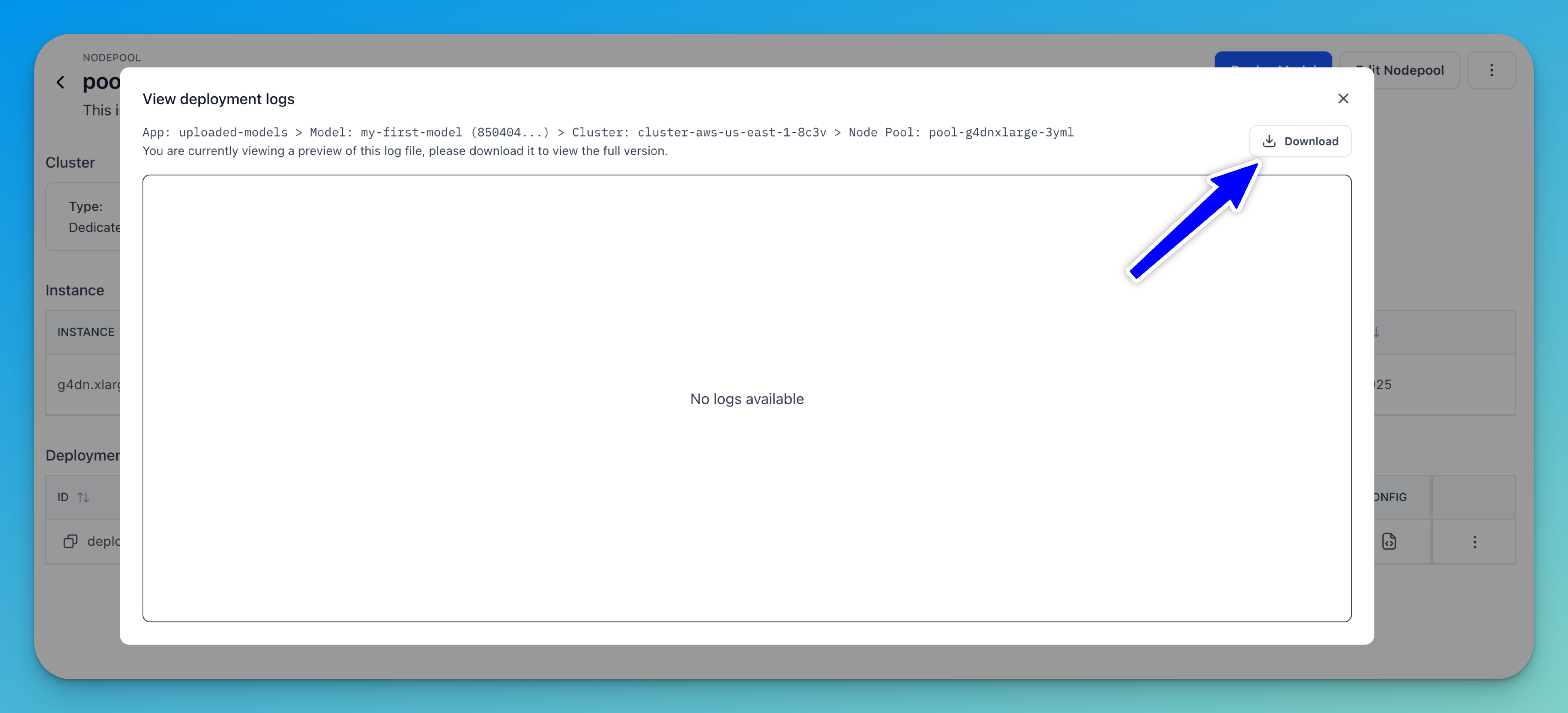
Edit a Deployment
To edit a deployment, navigate to the Deployments table and click the three-dot menu at the end of the corresponding row, as described previously.
Then, select the Deployment Setup option from the pop-up that appears.
You’ll be redirected to the deployment configuration page, where you can review and modify the model deployment settings as needed.
Delete a Deployment
To delete a deployment, navigate to the Deployments table and click the three-dot menu at the end of the corresponding row, as described previously.
Then, select the Delete Deployment option from the pop-up that appears.
A confirmation dialog will appear, warning you that this is a destructive action and cannot be undone. To complete the deletion, enter the name of the deployment in the provided field, then click Yes, Delete.
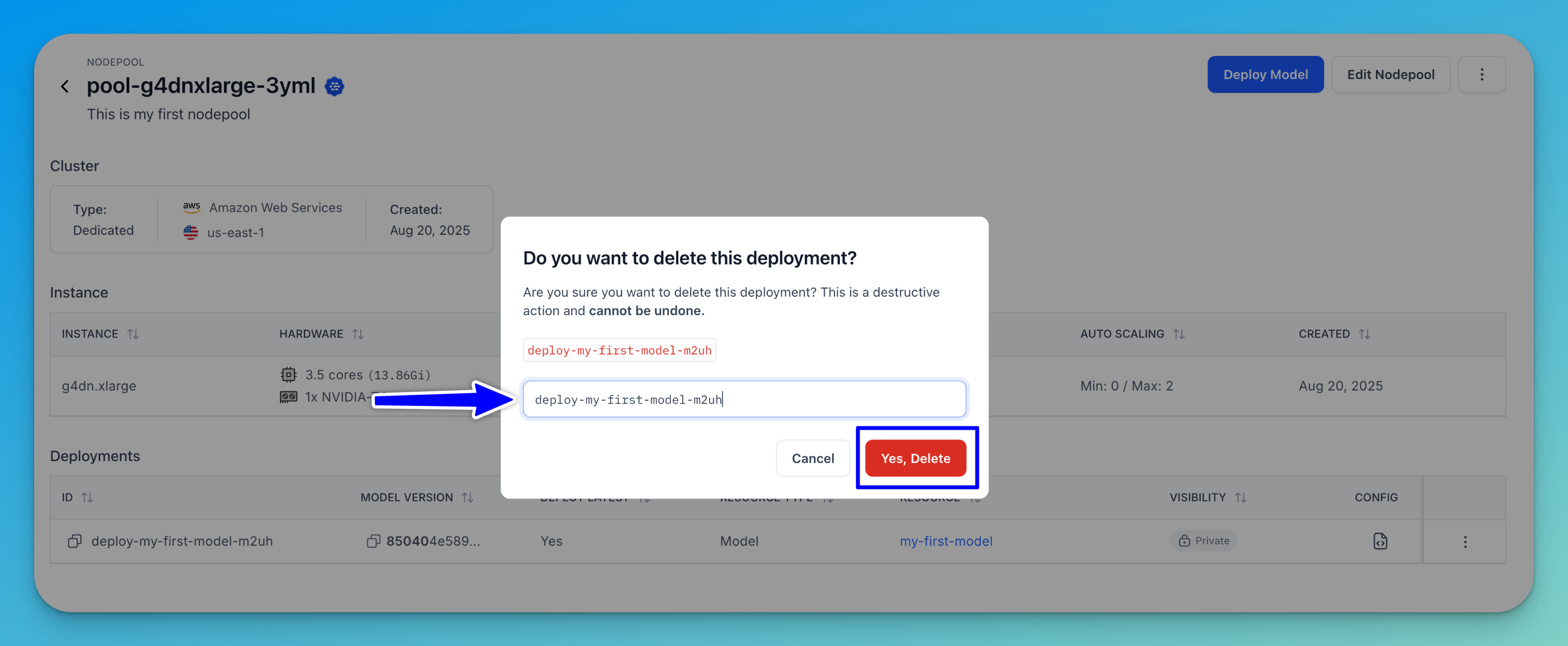
View Deployment Details
You can view deployment details directly from the Deployments table. Once you've located the desired deployment, hover over the CONFIG column (represented by the clipboard icon) in the same row.
A quick-access tooltip will appear, showing the autoscaling configuration for that deployment.
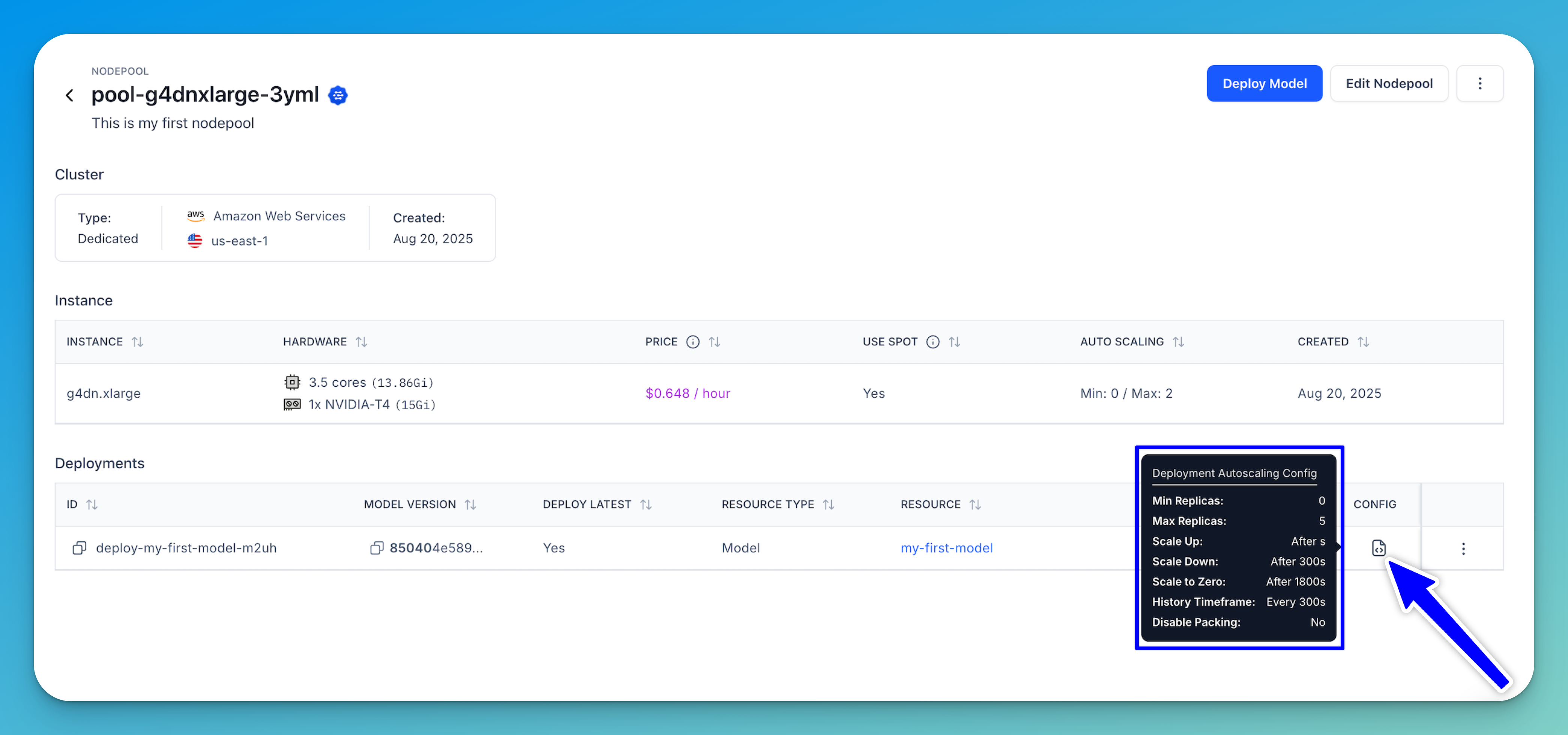
You can view a model’s deployment details by navigating to its individual page, selecting the Compute tab, and reviewing the Active Deployments section. You can find information about the compute environments where the model is currently running.
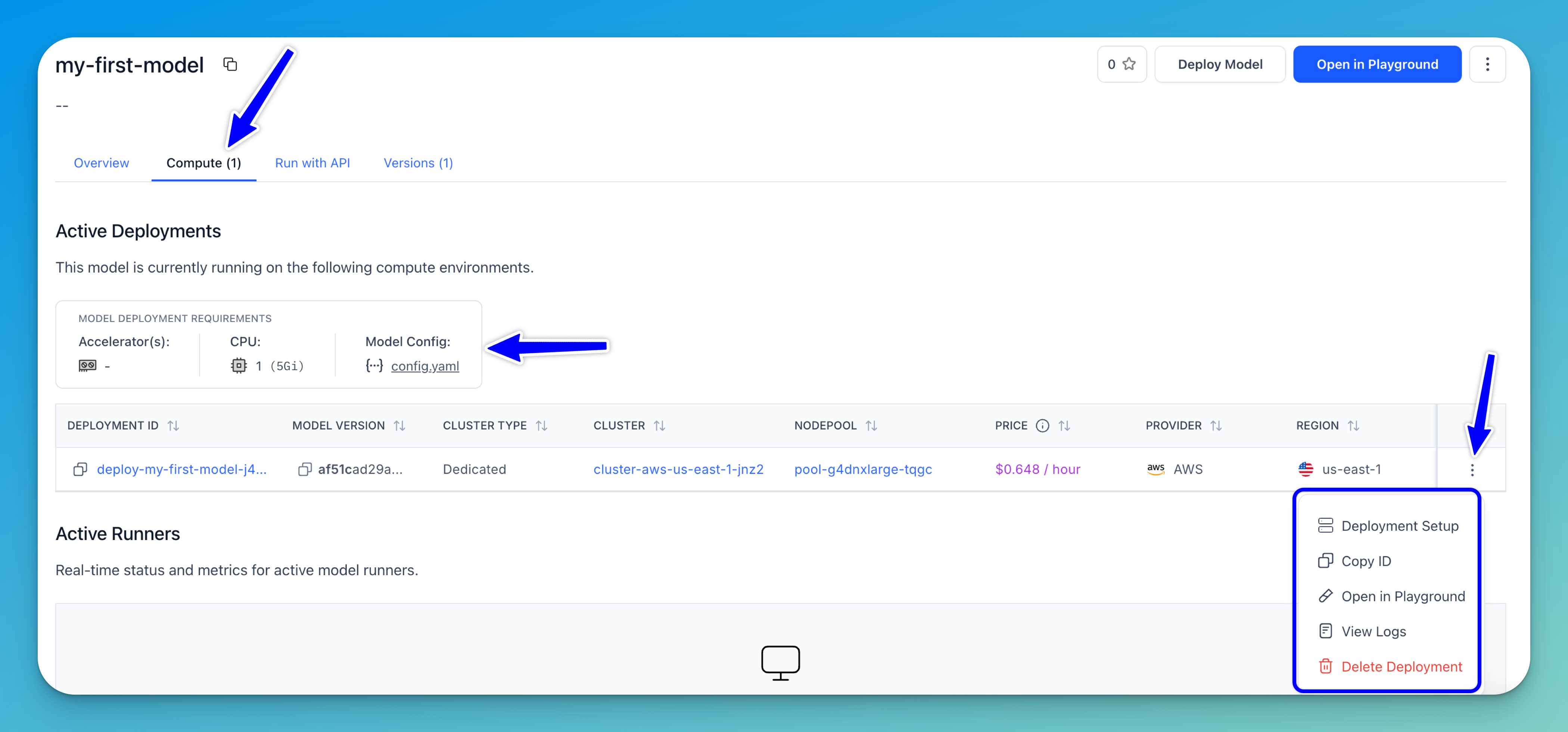
Also, clicking the three-dot menu at the end of the row in the table reveals different options that allow you to edit the deployment, copy the deployment ID, open the model in the Playground, view deployment logs, or delete the deployment.
Nodepools
Edit a Nodepool
To edit a nodepool, go to its individual page and click the Edit Nodepool button located in the upper-right corner of the screen.
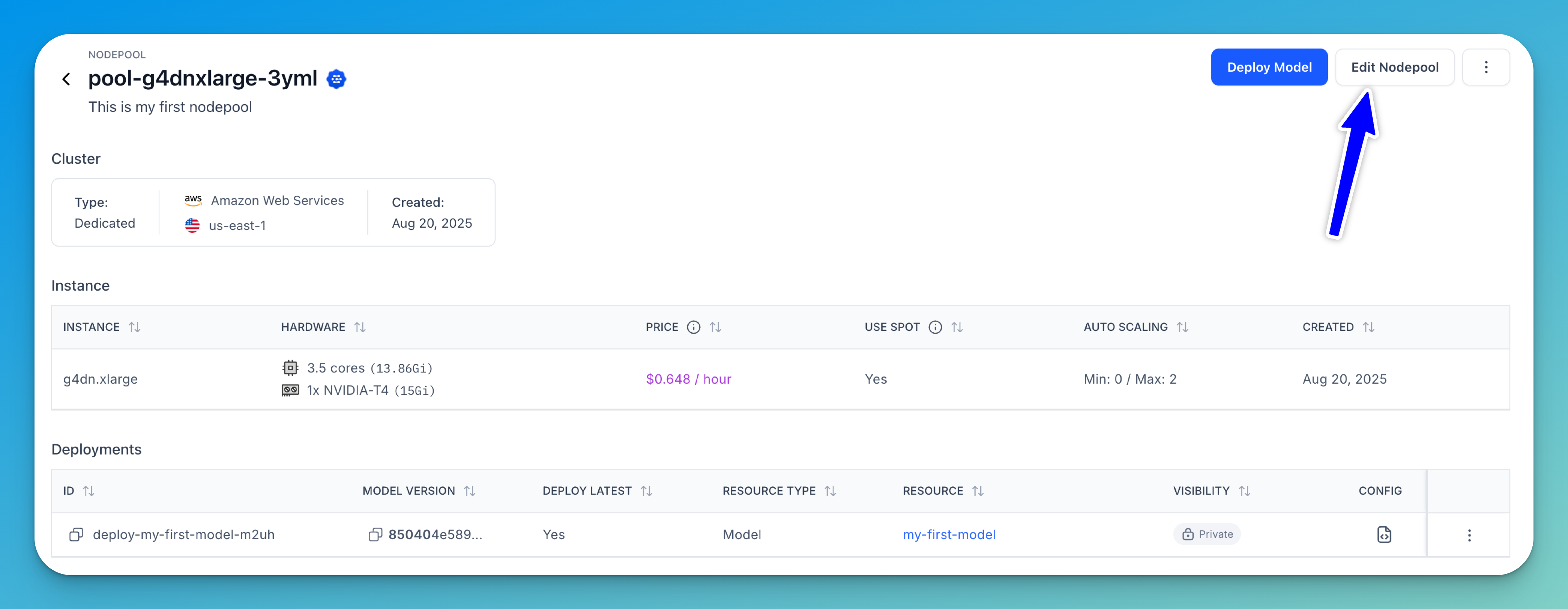
You'll be redirected to a page where you can modify the configurations for your nodepool based on your requirements.
You can perform various nodepool management tasks from the nodepools listing page. In the table, locate the nodepool you want to manage, then click the three-dot menu at the end of the row.
The pop-up that appears provides options to copy its ID, deploy a model to it, edit the nodepool, or delete the nodepool.
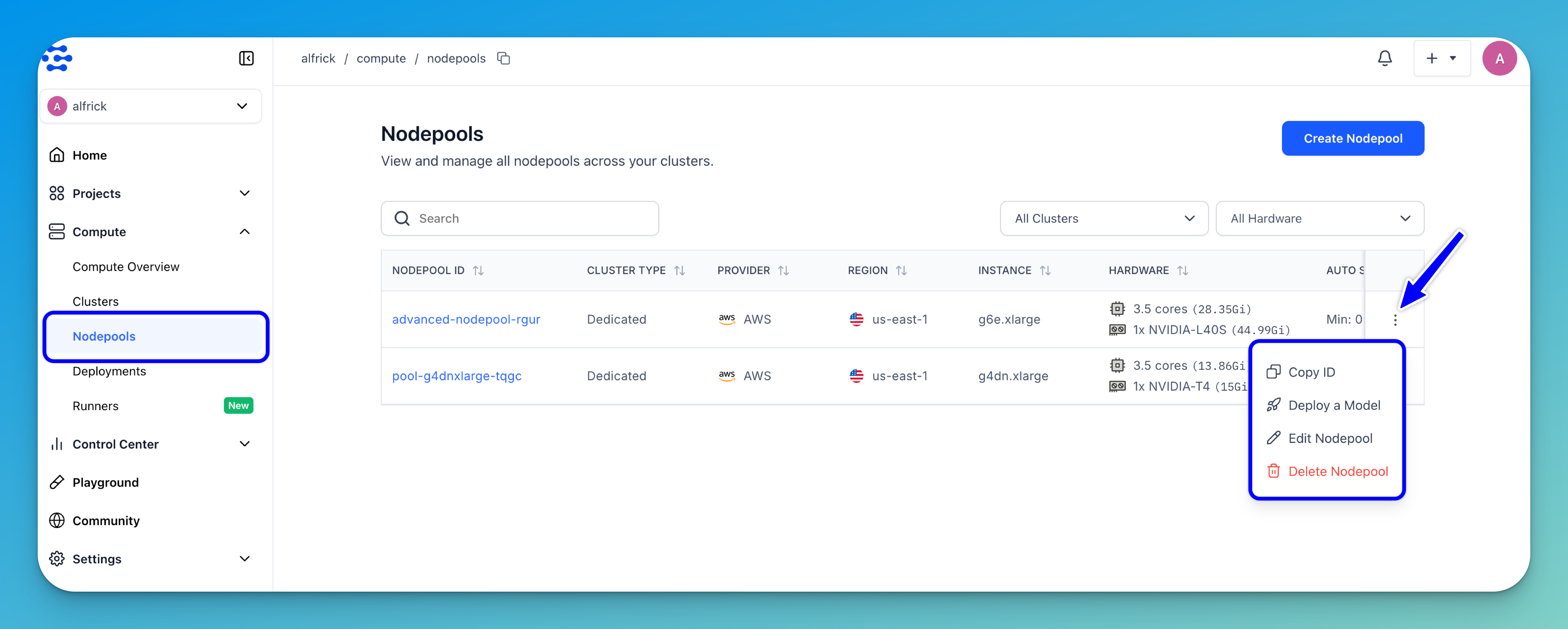
Delete a Nodepool
To delete a nodepool, go to its individual page and click the three-dot menu in the upper-right corner of the screen.
Then, click the Delete Nodepool button that appears.
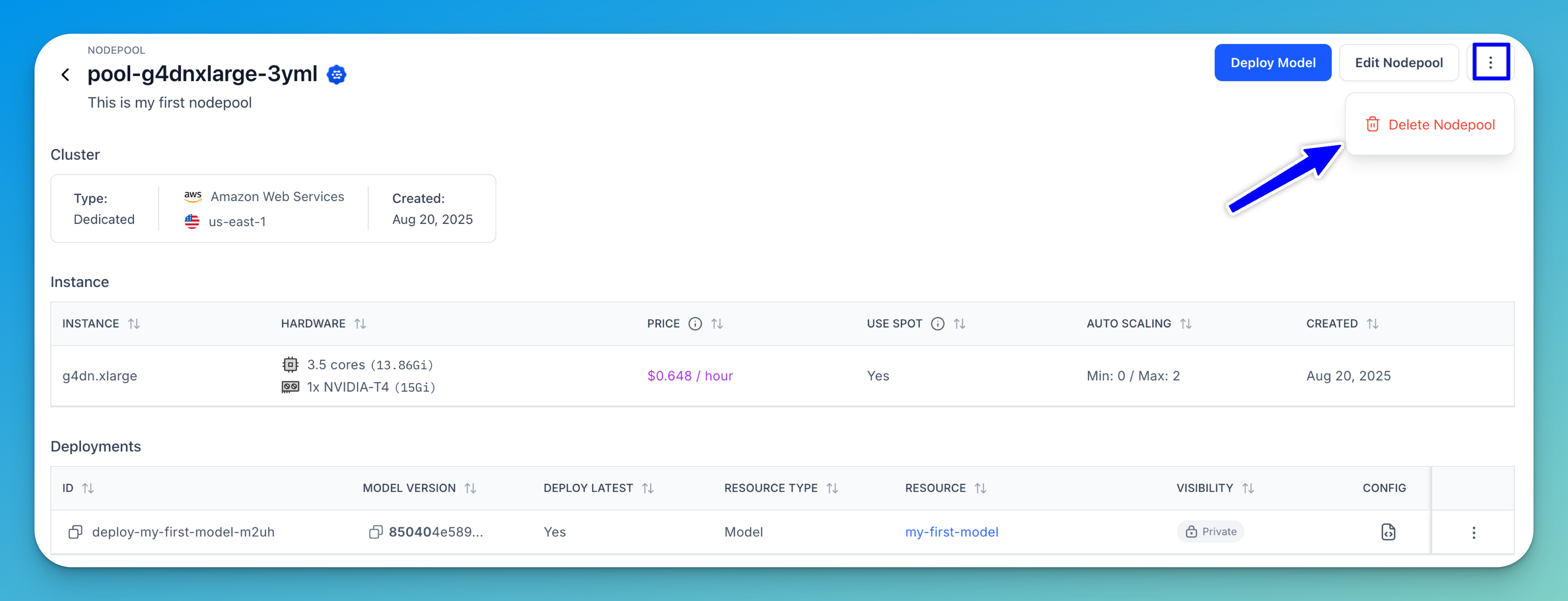
A confirmation pop-up will appear, warning you that deleting the nodepool will cause the associated deployments to stop functioning. So, you may reassign the deployments to a different nodepool if you want to continue using them.
Note that since this action cannot be undone, you need to proceed with caution. To complete the deletion, enter the name of the nodepool in the provided field, then click Yes, Delete.
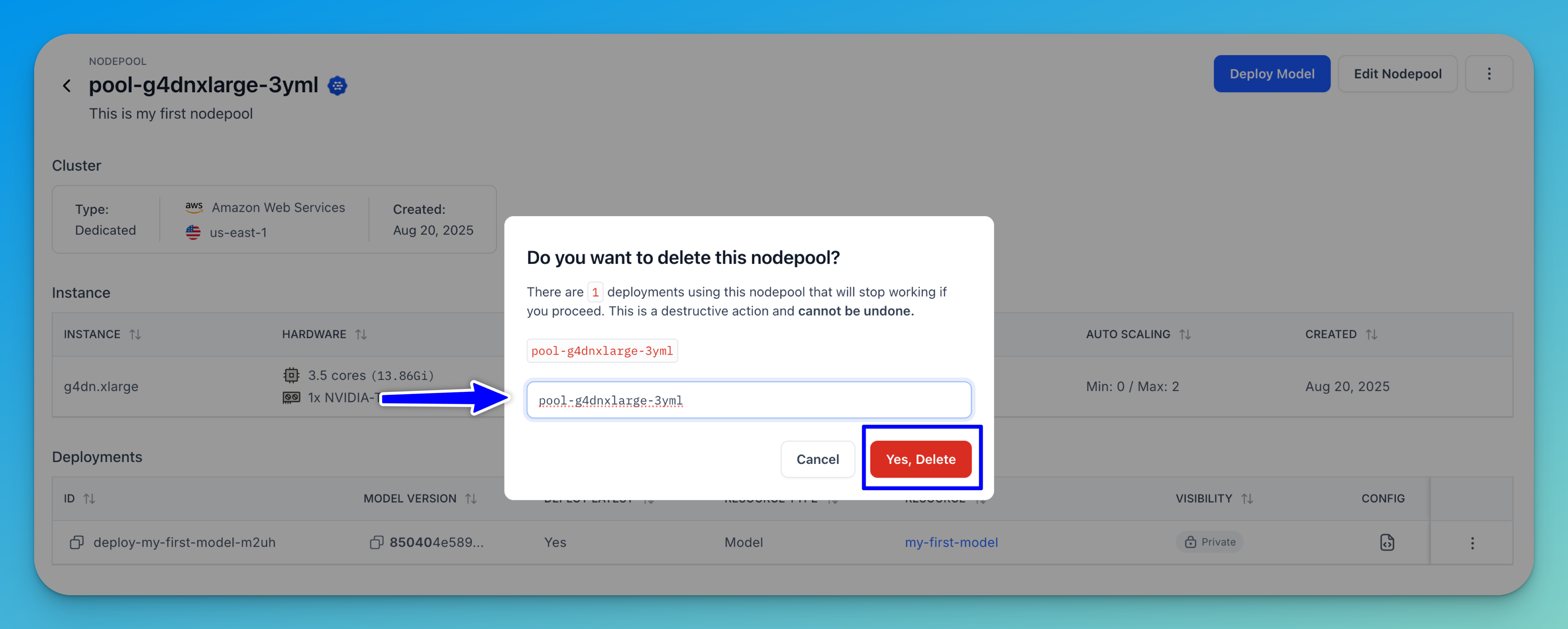
Clusters
Delete a Cluster
To delete a cluster, go to its individual page and click the three-dot menu in the upper-right corner of the screen.
Then, click the Delete Cluster button that appears.

A confirmation pop-up will appear, warning you that deleting the cluster will cause the associated nodepools to stop functioning. So, you may reassign the nodepools to a different cluster if you want to continue using them.
Note that since this action cannot be undone, you need to proceed with caution.
To complete the deletion, enter the name of the cluster in the provided field, then click Yes, Delete.
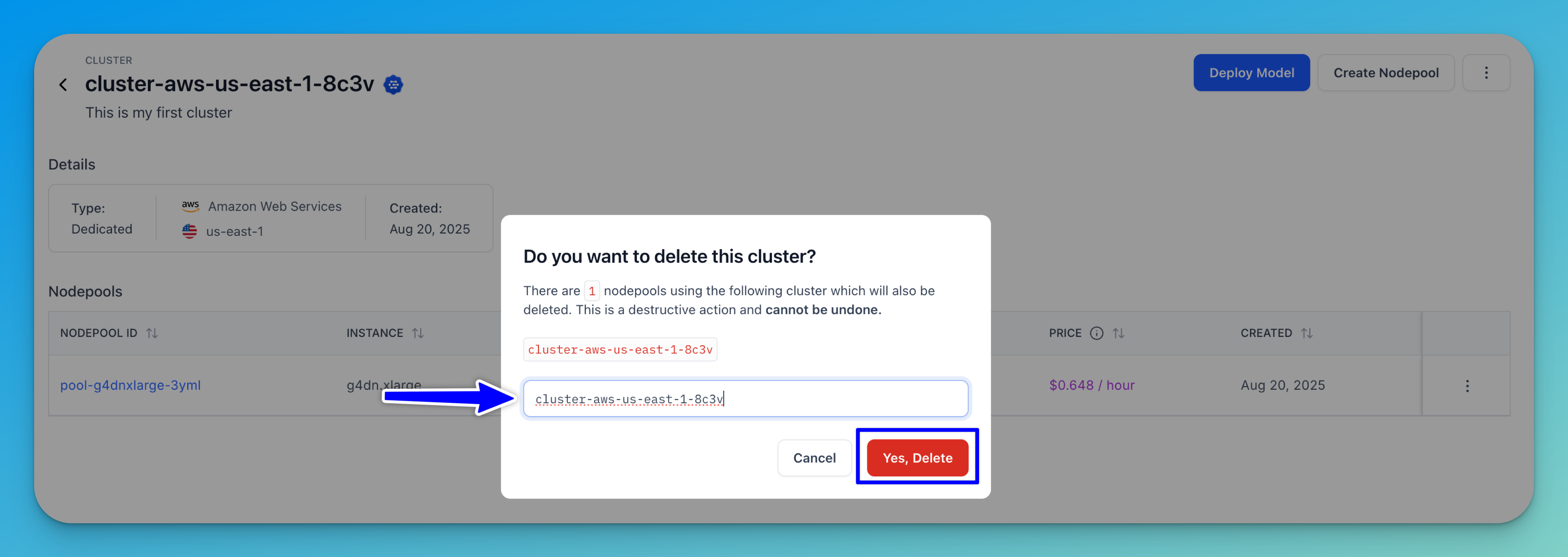
You can perform various cluster management tasks from the clusters listing page. In the table, locate the cluster you want to manage, then click the three-dot menu at the end of the row.
The pop-up that appears provides options to add a new nodepool, copy its ID, or delete the cluster.
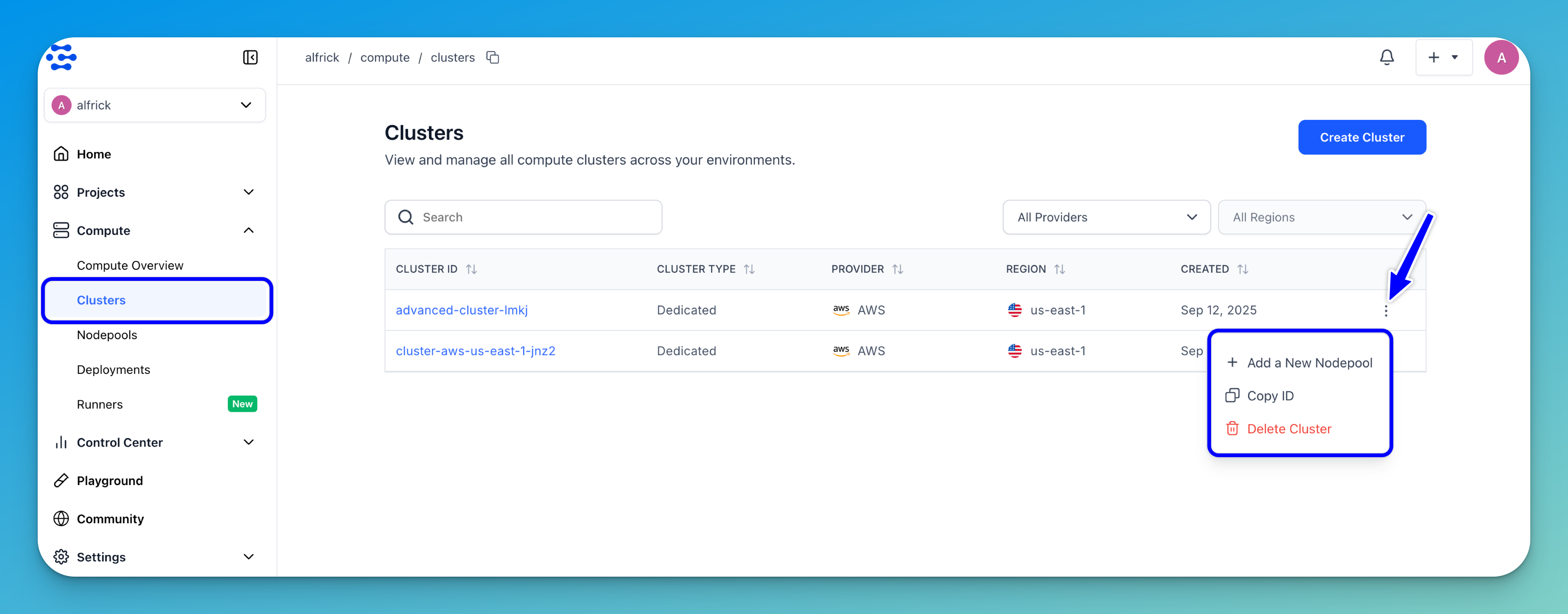
Via the API
A Personal Access Token (PAT) authenticates your connection to the Clarifai platform, including CLI sessions. Set the token as an environment variable as explained previously.
Clusters
Get a Cluster
To get the details of your compute cluster, pass the compute_cluster_id to the compute_cluster method of the User class.
- Python
from clarifai.client.user import User
# Set PAT as an environment variable
# export CLARIFAI_PAT=YOUR_PAT_HERE # Unix-Like Systems
# set CLARIFAI_PAT=YOUR_PAT_HERE # Windows
# Initialize the client
client = User(
user_id="YOUR_USER_ID_HERE"
)
# Get and print the compute cluster by providing its ID
compute_cluster = client.compute_cluster(
compute_cluster_id="test-compute-cluster"
)
print(compute_cluster)
Example Output
Clarifai Compute Cluster Details:
description=My AWS compute cluster, cloud_provider=id: "aws"
name: "AWS"
, region=us-east-1, created_at=seconds: 1757331634
nanos: 59523000
, modified_at=seconds: 1757331634
nanos: 59523000
, visibility=gettable: PRIVATE
, cluster_type=dedicated, managed_by=clarifai, key=id: "****"
, id=test-compute-cluster, user_id=alfrick
List All Clusters
To list all your existing compute clusters, call the list_compute_clusters method of the User class.
- Python
- CLI
from clarifai.client.user import User
# Set PAT as an environment variable
# export CLARIFAI_PAT=YOUR_PAT_HERE # Unix-Like Systems
# set CLARIFAI_PAT=YOUR_PAT_HERE # Windows
# Initialize the client
client = User(
user_id="YOUR_USER_ID_HERE"
)
# Fetch all compute clusters
all_compute_clusters = client.list_compute_clusters()
# Print them as a list
print("Available Compute Clusters:")
for cluster in all_compute_clusters:
print(f"- ID: {cluster.id}, Description: {cluster.description}, Region: {cluster.region}")
clarifai computecluster list
Example Output
Available Compute Clusters:
- ID: advanced-cluster-ebus, Description: , Region: us-east-1
- ID: test-compute-cluster, Description: My AWS compute cluster, Region: us-east-1
Nodepools
Get a Nodepool
To get the details of your nodepool, provide the nodepool_id to the nodepool method of the ComputeCluster class.
- Python
from clarifai.client.compute_cluster import ComputeCluster
# Set PAT as an environment variable
# export CLARIFAI_PAT=YOUR_PAT_HERE # Unix-Like Systems
# set CLARIFAI_PAT=YOUR_PAT_HERE # Windows
# Initialize the ComputeCluster instance
compute_cluster = ComputeCluster(
user_id="YOUR_USER_ID_HERE",
compute_cluster_id="test-compute-cluster"
)
# Get and print the nodepool by providing its ID
nodepool = compute_cluster.nodepool(
nodepool_id="test-nodepool"
)
print(nodepool)
Example Output
Nodepool Details:
description=First nodepool in AWS in a proper compute cluster, created_at=seconds: 1757331678
nanos: 990816000
, modified_at=seconds: 1757331678
nanos: 990816000
, compute_cluster=id: "test-compute-cluster"
description: "My AWS compute cluster"
cloud_provider {
id: "aws"
name: "AWS"
}
region: "us-east-1"
user_id: "alfrick"
created_at {
seconds: 1757331634
nanos: 59523000
}
modified_at {
seconds: 1757331634
nanos: 59523000
}
visibility {
gettable: PRIVATE
}
cluster_type: "dedicated"
managed_by: "clarifai"
key {
id: "****"
}
, node_capacity_type=capacity_types: ON_DEMAND_TYPE
, instance_types=[id: "g5.2xlarge"
description: "g5.2xlarge"
compute_info {
cpu_memory: "29033Mi"
num_accelerators: 1
accelerator_memory: "23028Mi"
accelerator_type: "NVIDIA-A10G"
cpu_limit: "7525m"
}
price: "42.000000"
cloud_provider {
id: "aws"
name: "aws"
}
region: "us-east-1"
], max_instances=1, visibility=gettable: PRIVATE
, enforced_max_instances=1, id=test-nodepool
List All Nodepools
To list all the existing nodepools in your cluster, call the list_nodepools method of the ComputeCluster class.
- Python
- CLI
from clarifai.client.compute_cluster import ComputeCluster
# Set PAT as an environment variable
# export CLARIFAI_PAT=YOUR_PAT_HERE # Unix-Like Systems
# set CLARIFAI_PAT=YOUR_PAT_HERE # Windows
# Initialize the ComputeCluster instance
compute_cluster = ComputeCluster(
user_id="YOUR_USER_ID_HERE",
compute_cluster_id="test-compute-cluster"
)
# Fetch all nodepools
all_nodepools = compute_cluster.list_nodepools()
# Print them as a list
print("Available Nodepools:")
for nodepool in all_nodepools:
print(f"- ID: {nodepool.id}, Description: {nodepool.description}, "
f"Min Instances: {nodepool.min_instances}, Max Instances: {nodepool.max_instances}")
clarifai nodepool list # List all nodepools across all compute clusters
clarifai nodepool list COMPUTE_CLUSTER_ID # List all nodepools in a specific compute cluster
Example Output
Available Nodepools:
- ID: test-nodepool, Description: First nodepool in AWS in a proper compute cluster, Min Instances: 0, Max Instances: 1
Deployments
Get a Deployment
To get the details of your deployment, provide the deployment_id to the deployment method of the Nodepool class.
- Python
from clarifai.client.nodepool import Nodepool
# Set PAT as an environment variable
# export CLARIFAI_PAT=YOUR_PAT_HERE # Unix-Like Systems
# set CLARIFAI_PAT=YOUR_PAT_HERE # Windows
# Initialize the Nodepool instance
nodepool = Nodepool(
user_id="YOUR_USER_ID_HERE",
nodepool_id="test-nodepool"
)
# Get and print the deployment by providing its ID
deployment = nodepool.deployment(
deployment_id="test-deployment"
)
print(deployment)
Example Output
Deployment Details:
autoscale_config=max_replicas: 5
traffic_history_seconds: 300
scale_down_delay_seconds: 300
scale_up_delay_seconds: 300
scale_to_zero_delay_seconds: 1800
, nodepools=[id: "test-nodepool"
description: "First nodepool in AWS in a proper compute cluster"
created_at {
seconds: 1757331678
nanos: 990816000
}
modified_at {
seconds: 1757331678
nanos: 990816000
}
compute_cluster {
id: "test-compute-cluster"
description: "My AWS compute cluster"
cloud_provider {
id: "aws"
name: "AWS"
}
region: "us-east-1"
user_id: "alfrick"
created_at {
seconds: 1757331634
nanos: 59523000
}
modified_at {
seconds: 1757331634
nanos: 59523000
}
visibility {
gettable: PRIVATE
}
cluster_type: "dedicated"
managed_by: "clarifai"
key {
id: "****"
}
}
node_capacity_type {
capacity_types: ON_DEMAND_TYPE
}
instance_types {
id: "g5.2xlarge"
description: "g5.2xlarge"
compute_info {
cpu_memory: "29033Mi"
num_accelerators: 1
accelerator_memory: "23028Mi"
accelerator_type: "NVIDIA-A10G"
cpu_limit: "7525m"
}
price: "42.000000"
cloud_provider {
id: "aws"
name: "aws"
}
region: "us-east-1"
}
max_instances: 1
visibility {
gettable: PRIVATE
}
enforced_max_instances: 1
], scheduling_choice=4, visibility=gettable: PRIVATE
, description=some random deployment, worker=model {
id: "Llama-3_2-3B-Instruct"
name: "Llama-3_2-3B-Instruct"
created_at {
seconds: 1741889414
nanos: 819619000
}
app_id: "Llama-3"
model_version {
id: "fe271b43266a45a5b068766b6437687f"
created_at {
seconds: 1748538551
nanos: 64876000
}
status {
code: MODEL_TRAINED
description: "Model is trained and ready for deployment"
}
completed_at {
seconds: 1748538558
nanos: 456045000
}
visibility {
gettable: PUBLIC
}
app_id: "Llama-3"
user_id: "meta"
inference_compute_info {
cpu_memory: "14Gi"
num_accelerators: 1
accelerator_memory: "21Gi"
accelerator_type: "NVIDIA-A10G"
accelerator_type: "NVIDIA-L40S"
accelerator_type: "NVIDIA-A100"
accelerator_type: "NVIDIA-H100"
cpu_limit: "3"
}
method_signatures {
name: "predict"
method_type: UNARY_UNARY
description: "Method to call from UI\n "
input_fields {
name: "prompt"
type: STR
default: "\"\""
}
input_fields {
name: "images"
type: LIST
type_args {
name: "images_item"
type: IMAGE
}
default: "[]"
}
input_fields {
name: "audios"
type: LIST
type_args {
name: "audios_item"
type: AUDIO
}
default: "[]"
}
input_fields {
name: "videos"
type: LIST
type_args {
name: "videos_item"
type: VIDEO
}
default: "[]"
}
input_fields {
name: "chat_history"
type: LIST
type_args {
name: "chat_history_item"
type: JSON_DATA
}
default: "[]"
}
input_fields {
name: "audio"
type: AUDIO
default: "null"
}
input_fields {
name: "video"
type: VIDEO
default: "null"
}
input_fields {
name: "image"
type: IMAGE
default: "null"
}
input_fields {
name: "tools"
type: LIST
type_args {
name: "tools_item"
type: JSON_DATA
}
default: "null"
}
input_fields {
name: "tool_choice"
type: STR
default: "null"
}
input_fields {
description: "The system-level prompt used to define the assistant\'s behavior."
name: "system_prompt"
type: STR
default: "\"\""
is_param: true
}
input_fields {
description: "The maximum number of tokens to generate. Shorter token lengths will provide faster performance."
name: "max_tokens"
type: INT
default: "512"
is_param: true
}
input_fields {
description: "A decimal number that determines the degree of randomness in the response."
name: "temperature"
type: FLOAT
default: "0.7"
is_param: true
}
input_fields {
description: "An alternative to sampling with temperature, where the model considers the results of the tokens with top_p probability mass."
name: "top_p"
type: FLOAT
default: "0.9"
is_param: true
}
output_fields {
name: "return"
type: STR
}
}
method_signatures {
name: "generate"
method_type: UNARY_STREAMING
description: "Method to call generate from UI\n "
input_fields {
name: "prompt"
type: STR
default: "\"\""
}
input_fields {
name: "images"
type: LIST
type_args {
name: "images_item"
type: IMAGE
}
default: "[]"
}
input_fields {
name: "audios"
type: LIST
type_args {
name: "audios_item"
type: AUDIO
}
default: "[]"
}
input_fields {
name: "videos"
type: LIST
type_args {
name: "videos_item"
type: VIDEO
}
default: "[]"
}
input_fields {
name: "chat_history"
type: LIST
type_args {
name: "chat_history_item"
type: JSON_DATA
}
default: "[]"
}
input_fields {
name: "audio"
type: AUDIO
default: "null"
}
input_fields {
name: "video"
type: VIDEO
default: "null"
}
input_fields {
name: "image"
type: IMAGE
default: "null"
}
input_fields {
name: "tools"
type: LIST
type_args {
name: "tools_item"
type: JSON_DATA
}
default: "null"
}
input_fields {
name: "tool_choice"
type: STR
default: "null"
}
input_fields {
description: "The system-level prompt used to define the assistant\'s behavior."
name: "system_prompt"
type: STR
default: "\"\""
is_param: true
}
input_fields {
description: "The maximum number of tokens to generate. Shorter token lengths will provide faster performance."
name: "max_tokens"
type: INT
default: "512"
is_param: true
}
input_fields {
description: "A decimal number that determines the degree of randomness in the response."
name: "temperature"
type: FLOAT
default: "0.7"
is_param: true
}
input_fields {
description: "An alternative to sampling with temperature, where the model considers the results of the tokens with top_p probability mass."
name: "top_p"
type: FLOAT
default: "0.9"
is_param: true
}
output_fields {
name: "return"
type: STR
iterator: true
}
}
method_signatures {
name: "openai_transport"
method_type: UNARY_UNARY
description: "The single model method to get the OpenAI-compatible request and send it to the OpenAI server\n then return its response.\n\nArgs:\n msg: JSON string containing the request parameters\n\nReturns:\n JSON string containing the response or error"
input_fields {
required: true
name: "msg"
type: STR
}
output_fields {
name: "return"
type: STR
}
}
method_signatures {
name: "openai_stream_transport"
method_type: UNARY_STREAMING
description: "Process an OpenAI-compatible request and return a streaming response iterator.\nThis method is used when stream=True and returns an iterator of strings directly,\nwithout converting to a list or JSON serializing.\n\nArgs:\n msg: The request as a JSON string.\n\nReturns:\n Iterator[str]: An iterator yielding text chunks from the streaming response."
input_fields {
required: true
name: "msg"
type: STR
}
output_fields {
name: "return"
type: STR
iterator: true
}
}
}
user_id: "meta"
model_type_id: "text-to-text"
visibility {
gettable: PUBLIC
}
description: "Llama 3.2 (3B) is a multilingual, instruction-tuned LLM by Meta, optimized for dialogue, retrieval, and summarization. It uses an autoregressive transformer with SFT and RLHF for improved alignment and outperforms many industry models."
modified_at {
seconds: 1751896217
nanos: 890327000
}
workflow_recommended {
value: true
}
image {
url: "https://data.clarifai.com/large/users/meta/apps/Llama-3/input_owners/phatvo/inputs/image/7b9fe837fdb9ed1272b35c98ef3b6245"
hosted {
prefix: "https://data.clarifai.com"
suffix: "users/meta/apps/Llama-3/input_owners/phatvo/inputs/image/7b9fe837fdb9ed1272b35c98ef3b6245"
sizes: "large"
sizes: "small"
crossorigin: "use-credentials"
}
}
billing_type: Tokens
featured_order {
value: 9950
}
}
, created_at=seconds: 1757331930
nanos: 95906000
, modified_at=seconds: 1757331930
nanos: 95906000
, id=test-deployment, user_id=alfrick
List All Deployments
To list all the existing deployments in your nodepool, call the list_deployments method of the Nodepool class.
- Python
- CLI
from clarifai.client.nodepool import Nodepool
# Set PAT as an environment variable
# export CLARIFAI_PAT=YOUR_PAT_HERE # Unix-Like Systems
# set CLARIFAI_PAT=YOUR_PAT_HERE # Windows
# Initialize the Nodepool instance
nodepool = Nodepool(
user_id="YOUR_USER_ID_HERE",
nodepool_id="test-nodepool"
)
# Fetch all deployments
all_deployments = nodepool.list_deployments()
# Print them as a list
print("Available Deployments:")
for deployment in all_deployments:
print(f"- ID: {deployment.id}, Description: {deployment.description}, "
f"Min Replicas: {deployment.autoscale_config.min_replicas}, "
f"Max Replicas: {deployment.autoscale_config.max_replicas}")
clarifai deployment list # List all deployments across all nodepools
clarifai deployment list NODEPOOL_ID # List all deployments in a specific nodepool
Example Output
Available Deployments:
- ID: test-deployment, Description: some random deployment, Min Replicas: 0, Max Replicas: 5
Delete Resources
Delete Deployments
To delete your deployments, pass a list of deployment IDs to the delete_deployments method of the Nodepool class.
- Python
- CLI
from clarifai.client.nodepool import Nodepool
# Set PAT as an environment variable
# export CLARIFAI_PAT=YOUR_PAT_HERE # Unix-Like Systems
# set CLARIFAI_PAT=YOUR_PAT_HERE # Windows
# Initialize the Nodepool instance
nodepool = Nodepool(
user_id="YOUR_USER_ID_HERE",
nodepool_id="test-nodepool"
)
# Get all the deployments in the nodepool
all_deployments = list(nodepool.list_deployments())
# Extract deployment IDs for deletion
deployment_ids = [deployment.id for deployment in all_deployments]
# Delete a specific deployment by providing its deployment ID
# deployment_ids = ["test-deployment"]
# Delete all the deployments
nodepool.delete_deployments(deployment_ids=deployment_ids)
clarifai deployment delete NODEPOOL_ID DEPLOYMENT_ID
Example Output
Deployments Deleted
code: SUCCESS
description: "Ok"
req_id: "sdk-python-11.7.5-a08b6c5f21674916ba5791df8eae5dd8"
Delete Nodepools
To delete your nodepools, provide a list of nodepool IDs to the delete_nodepools method of the ComputeCluster class.
- Python
- CLI
from clarifai.client.compute_cluster import ComputeCluster
# Set PAT as an environment variable
# export CLARIFAI_PAT=YOUR_PAT_HERE # Unix-Like Systems
# set CLARIFAI_PAT=YOUR_PAT_HERE # Windows
# Initialize the ComputeCluster instance
compute_cluster = ComputeCluster(
user_id="YOUR_USER_ID_HERE",
compute_cluster_id="test-compute-cluster"
)
# Get all nodepools within the compute cluster
all_nodepools = list(compute_cluster.list_nodepools())
# Extract nodepool IDs for deletion
nodepool_ids = [nodepool.id for nodepool in all_nodepools]
# Delete a specific nodepool by providing its ID
# nodepool_ids = ["test-nodepool"]
# Delete all the nodepools
compute_cluster.delete_nodepools(nodepool_ids=nodepool_ids)
clarifai nodepool delete COMPUTE_CLUSTER_ID NODEPOOL_ID
Example Output
Nodepools Deleted
code: SUCCESS
description: "Ok"
req_id: "sdk-python-11.7.5-d69f92a0263b41719b51083f44d6ed43"
Delete Compute Clusters
To delete your compute clusters, provide a list of compute cluster IDs to the delete_compute_clusters method of the User class.
- Python
- CLI
from clarifai.client.user import User
# Set PAT as an environment variable
# export CLARIFAI_PAT=YOUR_PAT_HERE # Unix-Like Systems
# set CLARIFAI_PAT=YOUR_PAT_HERE # Windows
# Initialize the User client
client = User(
user_id="YOUR_USER_ID_HERE"
)
# Get all compute clusters associated with the user
all_compute_clusters = list(client.list_compute_clusters())
# Extract compute cluster IDs for deletion
compute_cluster_ids = [compute_cluster.id for compute_cluster in all_compute_clusters]
# Delete a specific cluster by providing its ID
# compute_cluster_ids = ["test-compute-cluster"]
# Delete all the compute clusters
client.delete_compute_clusters(compute_cluster_ids=compute_cluster_ids)
clarifai computecluster delete COMPUTE_CLUSTER_ID
Example Output
Compute Cluster Deleted
code: SUCCESS
description: "Ok"
req_id: "sdk-python-11.7.5-dc2a5ef7b8824ed0999dad18b5594a12"
List Cloud Providers
You can retrieve the available cloud providers to use when creating clusters and nodepools.
- cURL
curl -X GET "https://api.clarifai.com/v2/cloud_providers/" \
-H "Authorization: Key YOUR_PAT_HERE"
Example Output
{
"status": {
"code": 10000,
"description": "Ok",
"req_id": "4fc1ee4bd6a74215b363f30d28db4732"
},
"cloud_providers": [{
"id": "aws",
"name": "aws"
}, {
"id": "gcp",
"name": "gcp"
}, {
"id": "azure",
"name": "azure"
}, {
"id": "vultr",
"name": "vultr"
}, {
"id": "oracle",
"name": "oracle"
}]
}
List Regions
You can retrieve the geographic regions supported by a cloud provider.
- cURL
curl -X GET "https://api.clarifai.com/v2/cloud_providers/{{cloud_provider_id}}/regions/" \
-H "Authorization: Key YOUR_PAT_HERE"
Example Output
{
"status": {
"code": 10000,
"description": "Ok",
"req_id": "03c7a7a98a0f4e18a8a5818faf8e0a7c"
},
"regions": ["us-east-1"]
}
List Instance Types
You can retrieve the instance types a cloud provider offers in a given region
- cURL
curl -X GET "https://api.clarifai.com/v2/cloud_providers/{{cloud_provider_id}}/regions/{{region_id}}/instance_types" \
-H "Authorization: Key YOUR_PAT_HERE"
Example Output
{
"status": {
"code": 10000,
"description": "Ok",
"req_id": "1b7713b74b3643fda13d83802cd4036d"
},
"instance_types": [{
"id": "t3a.medium",
"description": "t3a.medium",
"compute_info": {
"cpu_limit": "1545m",
"cpu_memory": "2962Mi"
},
"price": "2.000000",
"cloud_provider": {
"id": "aws",
"name": "aws"
},
"region": "us-east-1",
"feature_flag_group": "ComputeResourceSmall"
}, {
"id": "t3a.large",
"description": "t3a.large",
"compute_info": {
"cpu_limit": "1545m",
"cpu_memory": "6553Mi"
},
"price": "3.000000",
"cloud_provider": {
"id": "aws",
"name": "aws"
},
"region": "us-east-1",
"feature_flag_group": "ComputeResourceSmall"
}, {
"id": "t3a.xlarge",
"description": "t3a.xlarge",
"compute_info": {
"cpu_limit": "3535m",
"cpu_memory": "13878Mi"
},
"price": "5.000000",
"cloud_provider": {
"id": "aws",
"name": "aws"
},
"region": "us-east-1",
"feature_flag_group": "ComputeResourceSmall"
}, {
"id": "t3a.2xlarge",
"description": "t3a.2xlarge",
"compute_info": {
"cpu_limit": "7525m",
"cpu_memory": "29033Mi"
},
"price": "10.000000",
"cloud_provider": {
"id": "aws",
"name": "aws"
},
"region": "us-east-1",
"feature_flag_group": "ComputeResourceSmall"
}, {
"id": "g4dn.xlarge",
"description": "g4dn.xlarge",
"compute_info": {
"cpu_limit": "3535m",
"cpu_memory": "14197Mi",
"num_accelerators": 1,
"accelerator_memory": "15360Mi",
"accelerator_type": ["NVIDIA-T4"]
},
"price": "18.000000",
"cloud_provider": {
"id": "aws",
"name": "aws"
},
"region": "us-east-1",
"feature_flag_group": "ComputeResourceSmall"
}, {
"id": "g5.xlarge",
"description": "g5.xlarge",
"compute_info": {
"cpu_limit": "3535m",
"cpu_memory": "13878Mi",
"num_accelerators": 1,
"accelerator_memory": "23028Mi",
"accelerator_type": ["NVIDIA-A10G"]
},
"price": "35.000000",
"cloud_provider": {
"id": "aws",
"name": "aws"
},
"region": "us-east-1",
"feature_flag_group": "ComputeResourceSmall"
}, {
"id": "g5.2xlarge",
"description": "g5.2xlarge",
"compute_info": {
"cpu_limit": "7525m",
"cpu_memory": "29033Mi",
"num_accelerators": 1,
"accelerator_memory": "23028Mi",
"accelerator_type": ["NVIDIA-A10G"]
},
"price": "42.000000",
"cloud_provider": {
"id": "aws",
"name": "aws"
},
"region": "us-east-1",
"feature_flag_group": "ComputeResourceSmall"
}, {
"id": "g6.xlarge",
"description": "g6.xlarge",
"compute_info": {
"cpu_limit": "3535m",
"cpu_memory": "13878Mi",
"num_accelerators": 1,
"accelerator_memory": "23034Mi",
"accelerator_type": ["NVIDIA-L4"]
},
"price": "28.000000",
"cloud_provider": {
"id": "aws",
"name": "aws"
},
"region": "us-east-1",
"feature_flag_group": "ComputeResourceSmall"
}, {
"id": "g6.2xlarge",
"description": "g6.2xlarge",
"compute_info": {
"cpu_limit": "7525m",
"cpu_memory": "29033Mi",
"num_accelerators": 1,
"accelerator_memory": "23034Mi",
"accelerator_type": ["NVIDIA-L4"]
},
"price": "34.000000",
"cloud_provider": {
"id": "aws",
"name": "aws"
},
"region": "us-east-1",
"feature_flag_group": "ComputeResourceSmall"
}, {
"id": "g6e.xlarge",
"description": "g6e.xlarge",
"compute_info": {
"cpu_limit": "3535m",
"cpu_memory": "29033Mi",
"num_accelerators": 1,
"accelerator_memory": "46068Mi",
"accelerator_type": ["NVIDIA-L40S"]
},
"price": "65.000000",
"cloud_provider": {
"id": "aws",
"name": "aws"
},
"region": "us-east-1",
"feature_flag_group": "ComputeResourceMedium"
}, {
"id": "g6e.2xlarge",
"description": "g6e.2xlarge",
"compute_info": {
"cpu_limit": "7525m",
"cpu_memory": "59343Mi",
"num_accelerators": 1,
"accelerator_memory": "46068Mi",
"accelerator_type": ["NVIDIA-L40S"]
},
"price": "78.000000",
"cloud_provider": {
"id": "aws",
"name": "aws"
},
"region": "us-east-1",
"feature_flag_group": "ComputeResourceMedium"
}, {
"id": "g6e.12xlarge",
"description": "g6e.12xlarge",
"compute_info": {
"cpu_limit": "47425m",
"cpu_memory": "359873Mi",
"num_accelerators": 4,
"accelerator_memory": "46068Mi",
"accelerator_type": ["NVIDIA-L40S"]
},
"price": "364.000000",
"cloud_provider": {
"id": "aws",
"name": "aws"
},
"region": "us-east-1",
"feature_flag_group": "ComputeResourceLarge"
}]
}
List All Instance Types
You can retrieve all instance types offered by all cloud providers across their supported regions.
- cURL
curl -X GET "https://api.clarifai.com/v2/cloud_providers/all/regions/all/instance_types/" \
-H "Authorization: Key YOUR_PAT_HERE"
Example Output
{
"status": {
"code": 10000,
"description": "Ok",
"req_id": "c57a6284e829442884e3daa41bd8cbe1"
},
"instance_types": [{
"id": "t3a.medium",
"description": "t3a.medium",
"compute_info": {
"cpu_limit": "1545m",
"cpu_memory": "2962Mi"
},
"price": "2.000000",
"cloud_provider": {
"id": "aws",
"name": "aws"
},
"region": "us-east-1",
"feature_flag_group": "ComputeResourceSmall"
}, {
"id": "t3a.large",
"description": "t3a.large",
"compute_info": {
"cpu_limit": "1545m",
"cpu_memory": "6553Mi"
},
"price": "3.000000",
"cloud_provider": {
"id": "aws",
"name": "aws"
},
"region": "us-east-1",
"feature_flag_group": "ComputeResourceSmall"
}, {
"id": "t3a.xlarge",
"description": "t3a.xlarge",
"compute_info": {
"cpu_limit": "3535m",
"cpu_memory": "13878Mi"
},
"price": "5.000000",
"cloud_provider": {
"id": "aws",
"name": "aws"
},
"region": "us-east-1",
"feature_flag_group": "ComputeResourceSmall"
}, {
"id": "t3a.2xlarge",
"description": "t3a.2xlarge",
"compute_info": {
"cpu_limit": "7525m",
"cpu_memory": "29033Mi"
},
"price": "10.000000",
"cloud_provider": {
"id": "aws",
"name": "aws"
},
"region": "us-east-1",
"feature_flag_group": "ComputeResourceSmall"
}, {
"id": "g4dn.xlarge",
"description": "g4dn.xlarge",
"compute_info": {
"cpu_limit": "3535m",
"cpu_memory": "14197Mi",
"num_accelerators": 1,
"accelerator_memory": "15360Mi",
"accelerator_type": ["NVIDIA-T4"]
},
"price": "18.000000",
"cloud_provider": {
"id": "aws",
"name": "aws"
},
"region": "us-east-1",
"feature_flag_group": "ComputeResourceSmall"
}, {
"id": "g5.xlarge",
"description": "g5.xlarge",
"compute_info": {
"cpu_limit": "3535m",
"cpu_memory": "13878Mi",
"num_accelerators": 1,
"accelerator_memory": "23028Mi",
"accelerator_type": ["NVIDIA-A10G"]
},
"price": "35.000000",
"cloud_provider": {
"id": "aws",
"name": "aws"
},
"region": "us-east-1",
"feature_flag_group": "ComputeResourceSmall"
}, {
"id": "g5.2xlarge",
"description": "g5.2xlarge",
"compute_info": {
"cpu_limit": "7525m",
"cpu_memory": "29033Mi",
"num_accelerators": 1,
"accelerator_memory": "23028Mi",
"accelerator_type": ["NVIDIA-A10G"]
},
"price": "42.000000",
"cloud_provider": {
"id": "aws",
"name": "aws"
},
"region": "us-east-1",
"feature_flag_group": "ComputeResourceSmall"
}, {
"id": "g6.xlarge",
"description": "g6.xlarge",
"compute_info": {
"cpu_limit": "3535m",
"cpu_memory": "13878Mi",
"num_accelerators": 1,
"accelerator_memory": "23034Mi",
"accelerator_type": ["NVIDIA-L4"]
},
"price": "28.000000",
"cloud_provider": {
"id": "aws",
"name": "aws"
},
"region": "us-east-1",
"feature_flag_group": "ComputeResourceSmall"
}, {
"id": "g6.2xlarge",
"description": "g6.2xlarge",
"compute_info": {
"cpu_limit": "7525m",
"cpu_memory": "29033Mi",
"num_accelerators": 1,
"accelerator_memory": "23034Mi",
"accelerator_type": ["NVIDIA-L4"]
},
"price": "34.000000",
"cloud_provider": {
"id": "aws",
"name": "aws"
},
"region": "us-east-1",
"feature_flag_group": "ComputeResourceSmall"
}, {
"id": "g6e.xlarge",
"description": "g6e.xlarge",
"compute_info": {
"cpu_limit": "3535m",
"cpu_memory": "29033Mi",
"num_accelerators": 1,
"accelerator_memory": "46068Mi",
"accelerator_type": ["NVIDIA-L40S"]
},
"price": "65.000000",
"cloud_provider": {
"id": "aws",
"name": "aws"
},
"region": "us-east-1",
"feature_flag_group": "ComputeResourceMedium"
}, {
"id": "g6e.2xlarge",
"description": "g6e.2xlarge",
"compute_info": {
"cpu_limit": "7525m",
"cpu_memory": "59343Mi",
"num_accelerators": 1,
"accelerator_memory": "46068Mi",
"accelerator_type": ["NVIDIA-L40S"]
},
"price": "78.000000",
"cloud_provider": {
"id": "aws",
"name": "aws"
},
"region": "us-east-1",
"feature_flag_group": "ComputeResourceMedium"
}, {
"id": "g6e.12xlarge",
"description": "g6e.12xlarge",
"compute_info": {
"cpu_limit": "47425m",
"cpu_memory": "359873Mi",
"num_accelerators": 4,
"accelerator_memory": "46068Mi",
"accelerator_type": ["NVIDIA-L40S"]
},
"price": "364.000000",
"cloud_provider": {
"id": "aws",
"name": "aws"
},
"region": "us-east-1",
"feature_flag_group": "ComputeResourceLarge"
}, {
"id": "a2-ultragpu-1g",
"description": "a2-ultragpu-1g",
"compute_info": {
"cpu_limit": "11338m",
"cpu_memory": "163054Mi",
"num_accelerators": 1,
"accelerator_memory": "81920Mi",
"accelerator_type": ["NVIDIA-A100"]
},
"price": "198.000000",
"cloud_provider": {
"id": "gcp",
"name": "gcp"
},
"region": "us-east4",
"feature_flag_group": "ComputeResourceMedium"
}, {
"id": "a3-highgpu-1g",
"description": "a3-highgpu-1g",
"compute_info": {
"cpu_limit": "25303m",
"cpu_memory": "227280Mi",
"num_accelerators": 1,
"accelerator_memory": "81559Mi",
"accelerator_type": ["NVIDIA-H100"]
},
"price": "384.000000",
"cloud_provider": {
"id": "gcp",
"name": "gcp"
},
"region": "us-east4",
"allowed_capacity_types": {
"capacity_types": [2]
},
"feature_flag_group": "ComputeResourceLarge"
}, {
"id": "ct5lp-hightpu-1t",
"description": "ct5lp-hightpu-1t",
"compute_info": {
"cpu_limit": "23308m",
"cpu_memory": "43740Mi",
"num_accelerators": 1,
"accelerator_type": ["GOOGLE-TPU-v5e"],
"accelerator_topology": ["1x1"]
},
"price": "65.000000",
"cloud_provider": {
"id": "gcp",
"name": "gcp"
},
"region": "us-central1",
"feature_flag_group": "ComputeResourceLarge"
}, {
"id": "ct5lp-hightpu-4t",
"description": "ct5lp-hightpu-4t",
"compute_info": {
"cpu_limit": "111088m",
"cpu_memory": "185132Mi",
"num_accelerators": 4,
"accelerator_type": ["GOOGLE-TPU-v5e"],
"accelerator_topology": ["2x2"]
},
"price": "65.000000",
"cloud_provider": {
"id": "gcp",
"name": "gcp"
},
"region": "us-central1",
"feature_flag_group": "ComputeResourceLarge"
}, {
"id": "ct5p-hightpu-4t",
"description": "ct5p-hightpu-4t",
"compute_info": {
"cpu_limit": "206848m",
"cpu_memory": "442033Mi",
"num_accelerators": 4,
"accelerator_type": ["GOOGLE-TPU-v5p"],
"accelerator_topology": ["2x2x1"]
},
"price": "65.000000",
"cloud_provider": {
"id": "gcp",
"name": "gcp"
},
"region": "us-central1",
"feature_flag_group": "ComputeResourceLarge"
}, {
"id": "ct6e-standard-1t",
"description": "ct6e-standard-1t",
"compute_info": {
"cpu_limit": "43258m",
"cpu_memory": "442033Mi",
"num_accelerators": 1,
"accelerator_type": ["GOOGLE-TPU-v6e"],
"accelerator_topology": ["1x1"]
},
"price": "65.000000",
"cloud_provider": {
"id": "gcp",
"name": "gcp"
},
"region": "us-central1",
"feature_flag_group": "ComputeResourceLarge"
}, {
"id": "ct6e-standard-4t",
"description": "ct6e-standard-4t",
"compute_info": {
"cpu_limit": "178918m",
"cpu_memory": "714990Mi",
"num_accelerators": 4,
"accelerator_type": ["GOOGLE-TPU-v6e"],
"accelerator_topology": ["2x2"]
},
"price": "65.000000",
"cloud_provider": {
"id": "gcp",
"name": "gcp"
},
"region": "us-central1",
"feature_flag_group": "ComputeResourceLarge"
}, {
"id": "g2-standard-12",
"description": "g2-standard-12",
"compute_info": {
"cpu_limit": "11338m",
"cpu_memory": "43740Mi",
"num_accelerators": 1,
"accelerator_memory": "23034Mi",
"accelerator_type": ["NVIDIA-L4"]
},
"price": "35.000000",
"cloud_provider": {
"id": "gcp",
"name": "gcp"
},
"region": "us-east4",
"feature_flag_group": "ComputeResourceSmall"
}, {
"id": "g2-standard-16",
"description": "g2-standard-16",
"compute_info": {
"cpu_limit": "15328m",
"cpu_memory": "59141Mi",
"num_accelerators": 1,
"accelerator_memory": "23034Mi",
"accelerator_type": ["NVIDIA-L4"]
},
"price": "40.000000",
"cloud_provider": {
"id": "gcp",
"name": "gcp"
},
"region": "us-east4",
"feature_flag_group": "ComputeResourceSmall"
}, {
"id": "g2-standard-32",
"description": "g2-standard-32",
"compute_info": {
"cpu_limit": "31288m",
"cpu_memory": "120906Mi",
"num_accelerators": 1,
"accelerator_memory": "23034Mi",
"accelerator_type": ["NVIDIA-L4"]
},
"price": "60.000000",
"cloud_provider": {
"id": "gcp",
"name": "gcp"
},
"region": "us-east4",
"feature_flag_group": "ComputeResourceSmall"
}, {
"id": "g2-standard-4",
"description": "g2-standard-4",
"compute_info": {
"cpu_limit": "3358m",
"cpu_memory": "12938Mi",
"num_accelerators": 1,
"accelerator_memory": "23034Mi",
"accelerator_type": ["NVIDIA-L4"]
},
"price": "25.000000",
"cloud_provider": {
"id": "gcp",
"name": "gcp"
},
"region": "us-east4",
"feature_flag_group": "ComputeResourceSmall"
}, {
"id": "g2-standard-8",
"description": "g2-standard-8",
"compute_info": {
"cpu_limit": "7348m",
"cpu_memory": "28339Mi",
"num_accelerators": 1,
"accelerator_memory": "23034Mi",
"accelerator_type": ["NVIDIA-L4"]
},
"price": "30.000000",
"cloud_provider": {
"id": "gcp",
"name": "gcp"
},
"region": "us-east4",
"feature_flag_group": "ComputeResourceSmall"
}, {
"id": "n2-standard-16",
"description": "n2-standard-16",
"compute_info": {
"cpu_limit": "15328m",
"cpu_memory": "59141Mi"
},
"price": "30.000000",
"cloud_provider": {
"id": "gcp",
"name": "gcp"
},
"region": "us-east4",
"feature_flag_group": "ComputeResourceSmall"
}, {
"id": "n2-standard-2",
"description": "n2-standard-2",
"compute_info": {
"cpu_limit": "1368m",
"cpu_memory": "5546Mi"
},
"price": "4.000000",
"cloud_provider": {
"id": "gcp",
"name": "gcp"
},
"region": "us-east4",
"feature_flag_group": "ComputeResourceSmall"
}, {
"id": "n2-standard-4",
"description": "n2-standard-4",
"compute_info": {
"cpu_limit": "3358m",
"cpu_memory": "12938Mi"
},
"price": "8.000000",
"cloud_provider": {
"id": "gcp",
"name": "gcp"
},
"region": "us-east4",
"feature_flag_group": "ComputeResourceSmall"
}, {
"id": "n2-standard-8",
"description": "n2-standard-8",
"compute_info": {
"cpu_limit": "7348m",
"cpu_memory": "28339Mi"
},
"price": "15.000000",
"cloud_provider": {
"id": "gcp",
"name": "gcp"
},
"region": "us-east4",
"feature_flag_group": "ComputeResourceSmall"
}, {
"id": "a2-ultragpu-1g",
"description": "a2-ultragpu-1g",
"compute_info": {
"cpu_limit": "11338m",
"cpu_memory": "163054Mi",
"num_accelerators": 1,
"accelerator_memory": "81920Mi",
"accelerator_type": ["NVIDIA-A100"]
},
"price": "198.000000",
"cloud_provider": {
"id": "gcp",
"name": "gcp"
},
"region": "us-east4",
"feature_flag_group": "ComputeResourceMedium"
}, {
"id": "a3-highgpu-1g",
"description": "a3-highgpu-1g",
"compute_info": {
"cpu_limit": "25303m",
"cpu_memory": "227280Mi",
"num_accelerators": 1,
"accelerator_memory": "81559Mi",
"accelerator_type": ["NVIDIA-H100"]
},
"price": "384.000000",
"cloud_provider": {
"id": "gcp",
"name": "gcp"
},
"region": "us-east4",
"allowed_capacity_types": {
"capacity_types": [2]
},
"feature_flag_group": "ComputeResourceLarge"
}, {
"id": "a3-highgpu-8g",
"description": "a3-highgpu-8g",
"compute_info": {
"cpu_limit": "206848m",
"cpu_memory": "1871045Mi",
"num_accelerators": 8,
"accelerator_memory": "81559Mi",
"accelerator_type": ["NVIDIA-H100"]
},
"price": "3073.000000",
"cloud_provider": {
"id": "gcp",
"name": "gcp"
},
"region": "us-east4",
"feature_flag_group": "ComputeResourceLarge"
}, {
"id": "g2-standard-12",
"description": "g2-standard-12",
"compute_info": {
"cpu_limit": "11338m",
"cpu_memory": "43740Mi",
"num_accelerators": 1,
"accelerator_memory": "23034Mi",
"accelerator_type": ["NVIDIA-L4"]
},
"price": "35.000000",
"cloud_provider": {
"id": "gcp",
"name": "gcp"
},
"region": "us-east4",
"feature_flag_group": "ComputeResourceSmall"
}, {
"id": "g2-standard-16",
"description": "g2-standard-16",
"compute_info": {
"cpu_limit": "15328m",
"cpu_memory": "59141Mi",
"num_accelerators": 1,
"accelerator_memory": "23034Mi",
"accelerator_type": ["NVIDIA-L4"]
},
"price": "40.000000",
"cloud_provider": {
"id": "gcp",
"name": "gcp"
},
"region": "us-east4",
"feature_flag_group": "ComputeResourceSmall"
}, {
"id": "g2-standard-32",
"description": "g2-standard-32",
"compute_info": {
"cpu_limit": "31288m",
"cpu_memory": "120906Mi",
"num_accelerators": 1,
"accelerator_memory": "23034Mi",
"accelerator_type": ["NVIDIA-L4"]
},
"price": "60.000000",
"cloud_provider": {
"id": "gcp",
"name": "gcp"
},
"region": "us-east4",
"feature_flag_group": "ComputeResourceSmall"
}, {
"id": "g2-standard-4",
"description": "g2-standard-4",
"compute_info": {
"cpu_limit": "3358m",
"cpu_memory": "12938Mi",
"num_accelerators": 1,
"accelerator_memory": "23034Mi",
"accelerator_type": ["NVIDIA-L4"]
},
"price": "25.000000",
"cloud_provider": {
"id": "gcp",
"name": "gcp"
},
"region": "us-east4",
"feature_flag_group": "ComputeResourceSmall"
}, {
"id": "g2-standard-8",
"description": "g2-standard-8",
"compute_info": {
"cpu_limit": "7348m",
"cpu_memory": "28339Mi",
"num_accelerators": 1,
"accelerator_memory": "23034Mi",
"accelerator_type": ["NVIDIA-L4"]
},
"price": "30.000000",
"cloud_provider": {
"id": "gcp",
"name": "gcp"
},
"region": "us-east4",
"feature_flag_group": "ComputeResourceSmall"
}, {
"id": "n2-standard-16",
"description": "n2-standard-16",
"compute_info": {
"cpu_limit": "15328m",
"cpu_memory": "59141Mi"
},
"price": "30.000000",
"cloud_provider": {
"id": "gcp",
"name": "gcp"
},
"region": "us-east4",
"feature_flag_group": "ComputeResourceSmall"
}, {
"id": "n2-standard-2",
"description": "n2-standard-2",
"compute_info": {
"cpu_limit": "1368m",
"cpu_memory": "5546Mi"
},
"price": "4.000000",
"cloud_provider": {
"id": "gcp",
"name": "gcp"
},
"region": "us-east4",
"feature_flag_group": "ComputeResourceSmall"
}, {
"id": "n2-standard-4",
"description": "n2-standard-4",
"compute_info": {
"cpu_limit": "3358m",
"cpu_memory": "12938Mi"
},
"price": "8.000000",
"cloud_provider": {
"id": "gcp",
"name": "gcp"
},
"region": "us-east4",
"feature_flag_group": "ComputeResourceSmall"
}, {
"id": "n2-standard-8",
"description": "n2-standard-8",
"compute_info": {
"cpu_limit": "7348m",
"cpu_memory": "28339Mi"
},
"price": "15.000000",
"cloud_provider": {
"id": "gcp",
"name": "gcp"
},
"region": "us-east4",
"feature_flag_group": "ComputeResourceSmall"
}, {
"id": "cl-xl-gpu-8-b200",
"description": "cl-xl-gpu-8-b200",
"compute_info": {
"cpu_limit": "207305m",
"cpu_memory": "2857011Mi",
"num_accelerators": 8,
"accelerator_memory": "183359Mi",
"accelerator_type": ["NVIDIA-B200"]
},
"price": "65.000000",
"cloud_provider": {
"id": "lambda",
"name": "lambda"
},
"region": "us-south-3",
"feature_flag_group": "ComputeResourceLarge"
}, {
"id": "local",
"description": "local runner",
"compute_info": {
"cpu_limit": "-105m",
"cpu_memory": "-455Mi"
},
"price": "0.000000",
"cloud_provider": {
"id": "local",
"name": "local"
},
"feature_flag_group": "ComputeResourceLocal"
}, {
"id": "BM.GPU.A10.4",
"description": "BM.GPU.A10.4",
"compute_info": {
"cpu_limit": "14788m",
"cpu_memory": "232872Mi",
"num_accelerators": 4,
"accelerator_memory": "23028Mi",
"accelerator_type": ["NVIDIA-A10G"]
},
"price": "65.000000",
"cloud_provider": {
"id": "oracle",
"name": "oracle"
},
"region": "us-chicago-1",
"feature_flag_group": "ComputeResourceMedium"
}, {
"id": "BM.GPU.MI300X.8",
"description": "BM.GPU.MI300X.8",
"compute_info": {
"cpu_limit": "111545m",
"cpu_memory": "1991694Mi",
"num_accelerators": 8,
"accelerator_memory": "127.816Gi",
"accelerator_type": ["AMD-MI300X"]
},
"price": "65.000000",
"cloud_provider": {
"id": "oracle",
"name": "oracle"
},
"region": "us-chicago-1",
"feature_flag_group": "ComputeResourceLarge"
}, {
"id": "VM.GPU.A10.1",
"description": "VM.GPU.A10.1",
"compute_info": {
"cpu_limit": "14788m",
"cpu_memory": "232872Mi",
"num_accelerators": 1,
"accelerator_memory": "23028Mi",
"accelerator_type": ["NVIDIA-A10G"]
},
"price": "65.000000",
"cloud_provider": {
"id": "oracle",
"name": "oracle"
},
"region": "us-chicago-1",
"feature_flag_group": "ComputeResourceSmall"
}, {
"id": "VM.Standard.E6.Flex",
"description": "VM.Standard.E6.Flex",
"compute_info": {
"cpu_limit": "835m",
"cpu_memory": "14964Mi"
},
"price": "65.000000",
"cloud_provider": {
"id": "oracle",
"name": "oracle"
},
"region": "us-chicago-1",
"feature_flag_group": "ComputeResourceSmall"
}, {
"id": "vbm-72c-480gb-gh200-gpu",
"description": "vbm-72c-480gb-gh200-gpu",
"compute_info": {
"cpu_limit": "71415m",
"cpu_memory": "466680Mi",
"num_accelerators": 1,
"accelerator_memory": "97871Mi",
"accelerator_type": ["NVIDIA-GH200"]
},
"price": "111.000000",
"cloud_provider": {
"id": "vultr",
"name": "vultr"
},
"region": "atlanta",
"feature_flag_group": "ComputeResourceMedium"
}, {
"id": "vbm-256c-2048gb-8-mi300x-gpu",
"description": "vbm-256c-2048gb-8-mi300x-gpu",
"compute_info": {
"cpu_limit": "255415m",
"cpu_memory": "1992030Mi",
"num_accelerators": 8,
"accelerator_memory": "127.816Gi",
"accelerator_type": ["AMD-MI300X"]
},
"price": "1109.000000",
"cloud_provider": {
"id": "vultr",
"name": "vultr"
},
"region": "chicago",
"feature_flag_group": "ComputeResourceLarge"
}, {
"id": "vc2-2c-4gb",
"description": "vc2-2c-4gb",
"compute_info": {
"cpu_limit": "1415m",
"cpu_memory": "3627Mi"
},
"price": "1.000000",
"cloud_provider": {
"id": "vultr",
"name": "vultr"
},
"region": "new-york",
"feature_flag_group": "ComputeResourceSmall"
}, {
"id": "vc2-4c-8gb",
"description": "vc2-4c-8gb",
"compute_info": {
"cpu_limit": "3415m",
"cpu_memory": "7518Mi"
},
"price": "2.000000",
"cloud_provider": {
"id": "vultr",
"name": "vultr"
},
"region": "new-york",
"feature_flag_group": "ComputeResourceSmall"
}, {
"id": "vc2-6c-16gb",
"description": "vc2-6c-16gb",
"compute_info": {
"cpu_limit": "5415m",
"cpu_memory": "15300Mi"
},
"price": "4.000000",
"cloud_provider": {
"id": "vultr",
"name": "vultr"
},
"region": "new-york",
"feature_flag_group": "ComputeResourceSmall"
}, {
"id": "vc2-8c-32gb",
"description": "vc2-8c-32gb",
"compute_info": {
"cpu_limit": "7415m",
"cpu_memory": "30865Mi"
},
"price": "8.000000",
"cloud_provider": {
"id": "vultr",
"name": "vultr"
},
"region": "new-york",
"feature_flag_group": "ComputeResourceSmall"
}, {
"id": "vc2-16c-64gb",
"description": "vc2-16c-64gb",
"compute_info": {
"cpu_limit": "15415m",
"cpu_memory": "61995Mi"
},
"price": "15.000000",
"cloud_provider": {
"id": "vultr",
"name": "vultr"
},
"region": "new-york",
"feature_flag_group": "ComputeResourceSmall"
}, {
"id": "vc2-24c-96gb",
"description": "vc2-24c-96gb",
"compute_info": {
"cpu_limit": "23415m",
"cpu_memory": "93124Mi"
},
"price": "30.000000",
"cloud_provider": {
"id": "vultr",
"name": "vultr"
},
"region": "new-york",
"feature_flag_group": "ComputeResourceSmall"
}, {
"id": "vcg-a16-6c-64g-16vram",
"description": "vcg-a16-6c-64g-16vram",
"compute_info": {
"cpu_limit": "5415m",
"cpu_memory": "61995Mi",
"num_accelerators": 1,
"accelerator_memory": "16Gi",
"accelerator_type": ["NVIDIA-A16"]
},
"price": "16.000000",
"cloud_provider": {
"id": "vultr",
"name": "vultr"
},
"region": "new-york",
"feature_flag_group": "ComputeResourceSmall"
}, {
"id": "vcg-a100-12c-120g-80vram",
"description": "vcg-a100-12c-120g-80vram",
"compute_info": {
"cpu_limit": "11415m",
"cpu_memory": "116472Mi",
"num_accelerators": 1,
"accelerator_memory": "81920Mi",
"accelerator_type": ["NVIDIA-A100"]
},
"price": "83.000000",
"cloud_provider": {
"id": "vultr",
"name": "vultr"
},
"region": "new-york",
"feature_flag_group": "ComputeResourceMedium"
}, {
"id": "vcg-l40s-16c-180g-48vram",
"description": "vcg-l40s-16c-180g-48vram",
"compute_info": {
"cpu_limit": "15415m",
"cpu_memory": "174840Mi",
"num_accelerators": 1,
"accelerator_memory": "46068Mi",
"accelerator_type": ["NVIDIA-L40S"]
},
"price": "58.000000",
"cloud_provider": {
"id": "vultr",
"name": "vultr"
},
"region": "new-york",
"feature_flag_group": "ComputeResourceMedium"
}, {
"id": "vcg-b200-248c-2826g-1536vram",
"description": "vcg-b200-248c-2826g-1536vram",
"compute_info": {
"cpu_limit": "255415m",
"cpu_memory": "1992030Mi",
"num_accelerators": 8,
"accelerator_memory": "183359Mi",
"accelerator_type": ["NVIDIA-B200"]
},
"price": "2220.000000",
"cloud_provider": {
"id": "vultr",
"name": "vultr"
},
"region": "seattle",
"feature_flag_group": "ComputeResourceLarge"
}]
}